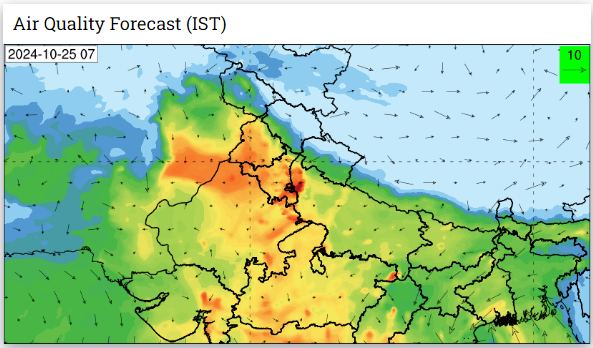Our Terms & Conditions | Our Privacy Policy
Not Just In Winter, Act All Year, Say Experts As Delhi Air Turns Toxic Despite GRAP-2
Last Updated:October 26, 2024, 00:00 IST
The AQI is likely to plunge into ‘severe’ levels over the next week, as PM2.5 and PM10 concentrations increase over the national capital
People and vehicles are seen on a road amidst the morning smog in New Delhi. (File photo: Reuters)
The measures outlined under the Graded Response Action Plan should be implemented all year round, not just in winter, say experts as Delhi’s air quality levels continue to deteriorate despite enforcement of stage 2 of GRAP. The Air Quality Index (AQI) has crossed 300, indicating high concentrations of PM2.5 and PM10.
The latest forecast from the Indian Institute of Tropical Meteorology (IITM) Pune suggests the AQI could plunge into severe category over the next week as the meteorological conditions remain unfavourable. The wind directions have changed to north-westerly, favouring smoke intrusion from stubble burning, while the bursting of firecrackers remains a worry.
“Normally, pollution levels begin to surge towards the end of October and early November when temperatures drop and the contribution of stubble burning increases. Even though stage 2 of GRAP has been enforced, it’s insufficient. The actions outlined in it should be implemented all year round, not just in the winter season,” says Shambhavi Shukla, programme manager at the New Delhi-based Centre for Science and Environment (CSE).

WEAK IMPLEMENTATION ON GROUND
Under stage 2 of GRAP, the Commission for Air Quality Management (CAQM) implores people to minimise personal vehicles, shift to public transport and avoid dust-generating activities as well as open burning of waste and biomass. The 11-point action plan also asks pollution-control agencies to start water sprinkling to minimise road dust, carry out vacuum/mechanical sweeping, as well as ensure uninterrupted power supply to discourage the use of diesel generator sets.
“GRAP is a band-aid solution. It has not worked in the past and it will not work this year as well. When the AQI reaches the ‘poor’ category, GRAP protocols are triggered. However, most measures within GRAP involve actions that should be standard practice year-round, regardless of air quality. Effective waste management, prohibiting open burning, enforcing pollution laws, managing traffic, and suppressing dust on roads and construction sites should all be routine — not emergency responses. Unfortunately, we only start implementing these when pollution reaches toxic levels,” remarked Dr Chandra Bhushan, president and CEO of iFOREST.
SAME PROBLEM, SAME SOURCES, NO SOLUTION
A real-time source apportionment study conducted by the IIT-Kanpur-led consortium in 2022-23 winter showed that secondary inorganic aerosols contributed 32% to Delhi’s pollution – these particles like nitrates and sulphates are formed by the interaction of toxic gases in the atmosphere which then travel far. This is followed by biomass burning within and outside Delhi (24%) and vehicular emissions (17%).
“The sources have remained the same—vehicles, biomass burning, waste burning, construction activities, and partly stubble burning—depending upon the weather patterns. It’s nothing different this year. We must, however, change our response to it. Desperate measures like cloud seeding for artificial rain are expensive and may not work. We need to invest in the electrification of goods movement (LCVs and HCVs), electric space heaters and electric cooking methods to avoid the burning of wood and charcoal, and eliminate open waste burning,” said Dr R Subramanian, Sector Head – of Air Quality at the Center for Study of Science, Technology & Policy (CSTEP).
Data shows that Delhi’s air is toxic all through the year, however, the pollution levels exceed the national air quality standards (NAAQS) by 5-6 times during winter. Professor Sagnik Dey from the Centre for Atmospheric Sciences, IIT Delhi said the challenge lies in weak implementation on the ground.
“The implementation has to be foolproof at all levels if we have to bend the curve – be it technological, policy-level and behaviour-wise. There is a new retrofit technology for DG sets which can significantly reduce emissions, but nobody is under any policy guidelines or compulsion to use it. We can run hundreds of public buses, but how can we convince people to use them? When it comes to implementation, we really lag behind,” added Professor Dey.
News india Not Just In Winter, Act All Year, Say Experts As Delhi Air Turns Toxic Despite GRAP-2
Images are for reference only.Images and contents gathered automatic from google or 3rd party sources.All rights on the images and contents are with their legal original owners.


Comments are closed.